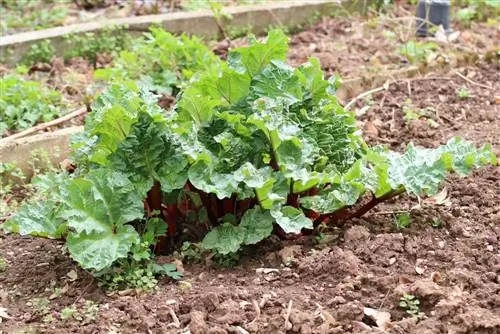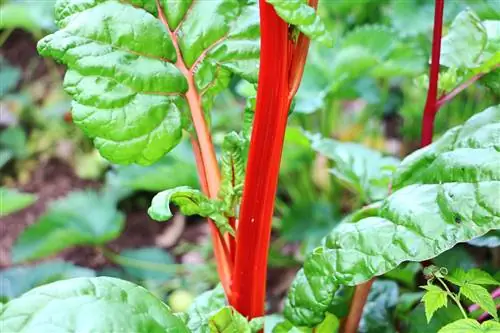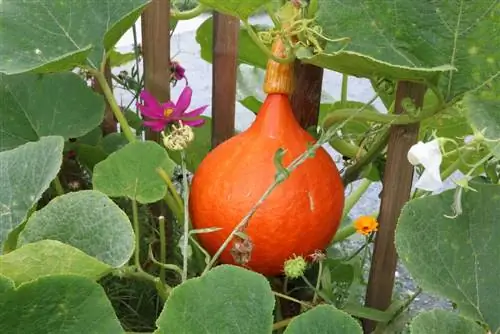- Author admin [email protected].
- Public 2023-12-17 03:39.
- Last modified 2025-06-01 06:48.
From compote to jam to juice - you can create a lot of things from rhubarb. It works just as well as a delicious cake topping in summer or in combination with strawberries and cream. It always scores with its tart acidity. It is what makes him unique, so to speak. It goes without saying that it belongs in every garden. Growing rhubarb is easy and straightforward. There are just a few basic points to consider when harvesting. After June 24th it is better to leave the vegetables.
Rhubarb - the basics
Many people think of rhubarb as fruit. In fact, from a botanical point of view, it is a vegetable. The fact that it is usually used in the kitchen like fruit and tastes more like fruit is undoubtedly one of the special features of this extraordinary plant. In the garden it loves heavy, sandy soil and a location that is as sunny as possible. Lots of light and lots of warmth ensure lush growth and a rich harvest. Rhubarb is planted either in autumn or spring. Please note the following:
- A distance of one to 1.5 meters must be maintained between the individual plants
- The plants have to be deep into the ground, only the buds are allowed to stick out of the ground
- water well immediately after planting
- Regular watering and fertilization is urgently needed during the growth phase
Basically, rhubarb does not require much care. If the location is right and the nutrient supply is right, it will grow and thrive on its own. Only weeds need to be removed regularly, as there is plenty of space between the plants in which they can develop. However, due to the large area, this should be possible and done quickly without too much effort and effort. Since rhubarb is also an extremely robust, resilient plant, in most cases you don't have to worry about pests and diseases. In short: growing rhubarb is basically child's play. There are only one or two small challenges during the harvest.
The first harvest
Rhubarb is a so-called heavy feeder. This means that it draws significantly more nutrients from the soil compared to other plants. This is precisely why regular fertilization is so important. Normally, heavy feeders have a relatively limited lifespan. Things are different with rhubarb. In the right location and with sufficient nutrient supply, a rhubarb plant can live up to seven years and can be harvested year after year.

To ensure that this really works and that you can enjoy the vegetable for a long time, it should not be harvested in the year it is planted. Although it will produce stems large enough to harvest in this first year, it is worth resisting and leaving the plant alone. As a reward, next year and the following years it will grow even more luxuriantly and produce an even richer harvest. At the same time, life expectancy is increasing.
Tip:
The first harvest is best done in the second year.
Harvest time
The ideal harvest time for rhubarb is a good two months. Under normal circumstances it begins in autumn and traditionally ends on June 24th, St. John's Day, which has always played a major role in the rural annual cycle. A specific end date for the harvest may initially seem a bit surprising and arbitrary. And of course the world won't end if you still harvest rhubarb on June 25th or 26th every year. The date certainly makes sense.
As with other plants, rhubarb also experiences another growth spurt towards the end of June. This is associated with a significant increase in oxalic acid in the stems. Oxalic acid is fundamentally toxic and can lead to kidney diseases such as kidney stones or kidney stones in humans. It is therefore a good idea not to eat the rhubarb stalks anymore. The summer growth spurt also ensures that the plant recharges its batteries for regeneration.
When does the harvest start?
As already mentioned, harvesting can take place from April onwards in the second year after planting. Of course, the crucial thing is that the stems are really ripe at this point. The degree of ripeness can actually be read directly from the stems or sticks. Particular attention must be paid to the fabric between the individual rod ribs.
As long as it is rather wavy, the rhubarb is not yet ripe. However, as soon as it smoothes out, it can be harvested without any concerns. Another clear indication is the change in color of the bars. When they are ripe, they usually shine in a rich red or a really fresh green. Incidentally, only the stalks and, under certain circumstances, the flowers of the rhubarb plant can be eaten. The leaves, on the other hand, are absolutely inedible.
How to harvest?

Rhubarb doesn't like blades. You should therefore never cut it. The reason for this is relatively simple: the resulting cut surfaces on the plants represent an injury, weaken the plant and are the ideal gateway for diseases. The stalks should therefore be harvested as follows:
- First grasp the pole at the base with your hand
- then carefully unscrew the rod clockwise until it comes loose
- cut off the leaves on the pole with a knife when the pole has been removed from the plant
- also cut off the whitish stalk at the base
- collect the individual rhubarb stalks loosely in a basket
- never harvest all the stalks, but leave at least one on the plant
The last point should not be underestimated. If you leave a few stalks on the plant, it will be easier for it to regenerate and you can expect a rich harvest the following year.
Speed up harvesting
The time in which rhubarb can be harvested is limited. It is of course an advantage if it starts a little earlier. In order to turn on the turbo when the rhubarb plant is growing and thus speed up the harvest, it is recommended to cover the plant with a fleece in spring and thus provide more warmth. A good layer of horse manure applied directly around the plant is also helpful.
Tip:
As soon as a flower bud appears on the rhubarb, break it out immediately. This saves the plant the energy and nutrients it invests in the poles.
Storage and consumption
After harvesting, the rhubarb stalks should definitely be stored in the refrigerator. The best way to do this is to wrap them in a damp kitchen towel. Contact with metals and especially aluminum should always be avoided because the oxalic acid contained in the rods reacts with metal. After all, oxalic acid is also the reason why rhubarb should never be eaten raw and must be peeled before processing. If you pay attention to these few points, nothing stands in the way of great rhubarb enjoyment.






